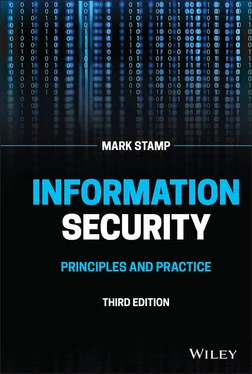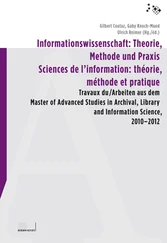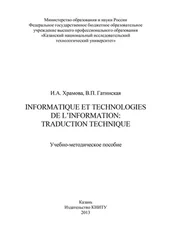Mark Stamp - Information Security
Здесь есть возможность читать онлайн «Mark Stamp - Information Security» — ознакомительный отрывок электронной книги совершенно бесплатно, а после прочтения отрывка купить полную версию. В некоторых случаях можно слушать аудио, скачать через торрент в формате fb2 и присутствует краткое содержание. Жанр: unrecognised, на английском языке. Описание произведения, (предисловие) а так же отзывы посетителей доступны на портале библиотеки ЛибКат.
- Название:Information Security
- Автор:
- Жанр:
- Год:неизвестен
- ISBN:нет данных
- Рейтинг книги:3 / 5. Голосов: 1
-
Избранное:Добавить в избранное
- Отзывы:
-
Ваша оценка:
- 60
- 1
- 2
- 3
- 4
- 5
Information Security: краткое содержание, описание и аннотация
Предлагаем к чтению аннотацию, описание, краткое содержание или предисловие (зависит от того, что написал сам автор книги «Information Security»). Если вы не нашли необходимую информацию о книге — напишите в комментариях, мы постараемся отыскать её.
Provides systematic guidance on meeting the information security challenges of the 21st century, featuring newly revised material throughout Information Security: Principles and Practice
Information Security
Information Security: Principles and Practice, Third Edition
Information Security — читать онлайн ознакомительный отрывок
Ниже представлен текст книги, разбитый по страницам. Система сохранения места последней прочитанной страницы, позволяет с удобством читать онлайн бесплатно книгу «Information Security», без необходимости каждый раз заново искать на чём Вы остановились. Поставьте закладку, и сможете в любой момент перейти на страницу, на которой закончили чтение.
Интервал:
Закладка:
15 Suppose that this textbook was sold online (as a PDF) by your money‐grubbing author for, say, $5. Then the author would make more money off each copy sold than he currently does 9 and people who purchase the book would save a lot of money.What are the security issues related to the sale of an online book?How could you make the selling of an online book more secure, from the copyright holder's perspective?How secure is your approach in part b)? How user‐friendly is your approach in part b)? What are some possible attacks on your proposed system?
16 The PowerPoint slides at [135] describe a security class project where students successfully hacked the Boston subway system.Summarize each of the various attacks. What was the crucial vulnerability that enabled each attack to succeed?The students planned to give a presentation at the self‐proclaimed “hacker's convention,” Defcon. At the request of the Boston transit authority, a judge issued a temporary restraining order that prevented the students from talking about their work. Do you think this was justified, based on the material in the slides?What are war dialing and war driving? What is war “carting”?Comment on the production quality of the “melodramatic video about the warcart” (a link to the video can be found at [124]).
Notes
1 1 Not to be confused with “Alice's Restaurant” [52].
2 2 No, not that CIA.
3 3 This sentence is brought to you by the Department of Redundancy Department.
4 4 You did read that, right?
5 5 If someone asks you why a specific weak security measure is used when better options are available, the correct answer is usually “money,” or it might simply be due to an inability to overcome inertia.
6 6 Access control list, or ACL, is one of many overloaded terms that arise in the field of information security.
7 7 Consider, for example, the infamous buffer overflow attack. Historically, this one of the most serious security flaws of all time. What is the grand theory behind this particular exploit? There isn't any—it's essentially made possible by a quirk in the way that memory is laid out in modern processors.
8 8 Shadoobie [116].
9 9 Believe it or not.
Chapter 2
Classic Crypto
The solution is by no means so difficult as you might be led to imagine from the first hasty inspection of the characters. These characters, as any one might readily guess, form a cipher—that is to say, they convey a meaning…
—Edgar Allan Poe, The Gold Bug




—ciphertext
2.1 Introduction
In this chapter we discuss some of the basic elements of cryptography. This discussion will lay the foundation for the remaining crypto chapters which, in turn, underpin much of the material throughout the book. We'll avoid mathematical rigor as much as possible. Nevertheless, there is enough detail here so that you will not only understand the “what″ but you will also have some appreciation for the “how″ and “why.″
After this introductory chapter, the remaining crypto chapters focus on modern symmetric key cryptography, public key cryptography, and cryptographic hash functions. A handful of topics that are related to cryptography—but not exactly cryptography, per se—are also covered in later chapters.
2.2 How to Speak Crypto
The basic terminology of crypto includes the following:
Cryptology— The art and science of making and breaking “secret codes.″
Cryptography— The making of “secret codes.″
Cryptanalysis— The breaking of “secret codes.″
Crypto— A synonym for any or all of the above (and more), where the precise meaning should be clear from context.
A cipher or cryptosystem is used to encrypt data. The original, unencrypted data is known as plaintext, and the result of encryption is ciphertext. We decrypt the ciphertext to recover the original plaintext. A key is used to configure a cryptosystem for encryption and decryption.
In a symmetric cipher, the same key is used to encrypt and to decrypt, as illustrated by the black box 1 cryptosystem in Figure 2.1. There is also a concept of public key cryptography where the encryption and decryption keys are different. In public key cryptography, we can make the encryption key public—thus the name public key. 2 In public key crypto, the encryption key is, appropriately, known as the public key, whereas the decryption key, which must remain secret, is the private key. In symmetric key crypto, the key is known as a symmetric key. We'll avoid the ambiguous term “secret key.″

Figure 2.1 Crypto as a black box
For an ideal cipher, it is infeasible to recover the plaintext from the ciphertext without the key. That is, even if the attacker, Trudy, has complete knowledge of the algorithms used and lots of other information (to be made more precise later), she can't recover the plaintext without the key. That's the goal, although reality sometimes differs.
A fundamental tenet of cryptography is that the inner workings of a cryptosystem are completely known to the attacker, Trudy, and the only secret aspect is a key. This is known as Kerckhoffs’ principle, which, believe it or not, is due to a guy named Kerckhoffs.
In 1883, Kerckhoffs, a Dutch linguist and cryptographer, laid out six principles of cipher design and use [67]. The principle that now bears his name states (among other things) that a cipher “must not be required to be secret, and it must be able to fall into the hands of the enemy without inconvenience.″ This implies that the design of the cipher is not secret.
What is the point of Kerckhoffs’ principle? After all, it must certainly be more difficult for Trudy to attack a cryptosystem if she doesn't know how the cipher works. So, at first glance, it might seem that Kerckhoff is making Trudy's life easier, which is something that we never want to do. There are at least a couple of problems with trying to rely on a secret design for your security. For one, the details of “secret″ systems (whether in cryptography or elsewhere) seldom, if ever, remain secret for long. Reverse engineering can be used to recover algorithms from software, and even algorithms embedded in tamper‐resistant hardware are sometimes subject to reverse engineering attacks and exposure. And, even more worrisome is the fact that secret crypto‐algorithms have a long history of failing to be secure once they have been exposed to public scrutiny—see [50] for a relatively modern example where Microsoft violated Kerckhoffs’ principle.
Cryptographers will not deem a crypto‐algorithm to be worthy until it has withstood extensive public analysis by many knowledgeable cryptographers. The bottom line is that any cryptosystem that does not satisfy Kerckhoffs’ principle is suspect. In other words, ciphers are presumed “guilty″ until “proven″ innocent. Actually, no practical ciphers are proven secure, but there must be a solid body of cryptanalysis indicating that a cipher is not easy to break.
Читать дальшеИнтервал:
Закладка:
Похожие книги на «Information Security»
Представляем Вашему вниманию похожие книги на «Information Security» списком для выбора. Мы отобрали схожую по названию и смыслу литературу в надежде предоставить читателям больше вариантов отыскать новые, интересные, ещё непрочитанные произведения.
Обсуждение, отзывы о книге «Information Security» и просто собственные мнения читателей. Оставьте ваши комментарии, напишите, что Вы думаете о произведении, его смысле или главных героях. Укажите что конкретно понравилось, а что нет, и почему Вы так считаете.











